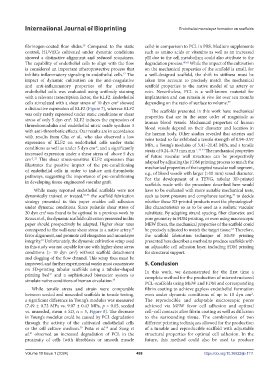Page 496 - IJB-10-1
P. 496
International Journal of Bioprinting Endothelial monolayer formation on scaffolds
fibrinogen-coated flow slides. Compared to the static cells) in comparison to PCL in PBS. Medium supplements
20
control, HUVECs cultivated under dynamic conditions such as amino acids or vitamins as well as an increased
showed a distinctive alignment and reduced roundness. pH due to the cell metabolism could also attribute to the
The capability of endothelial cells to align with the flow degradation process. 40,41 While the impact of the cultivation
is considered an important atheroprotective process that on the mechanical properties of the scaffold is small, for
inhibits inflammatory signaling in endothelial cells. The a well-designed scaffold, the shift in stiffness must be
17
impact of dynamic cultivation on the anti-coagulative taken into account to precisely match the mechanical
and anti-inflammatory properties of the cultivated scaffold properties to the native model of an artery or
endothelial cells was evaluated using antibody staining vein. Nevertheless, PCL is a well-known material for
with a relevant transcription factor, the KLF2. Endothelial implantation and can remain in vivo for over ten months
cells stimulated with a shear stress of 10 dyn cm showed depending on the ratio of surface to volume.
39
2
a distinctive expression of KLF2 (Figure 7), whereas KLF2 The scaffolds presented in this work have mechanical
was only rarely expressed under static conditions or shear properties that are in the same order of magnitude as
stress of only 5 dyn cm . KLF2 induces the expression of human blood vessels. Mechanical properties of human
2
thrombomodulin and endothelial nitric oxide synthase 3 blood vessels depend on their diameter and location in
with anti-thrombotic effects. Our results are in accordance the human body. Other studies revealed that arteries and
with results from Chu et al., who also observed a low veins tested so far exhibited a tensile strength of 0.94–3.97
expression of KLF2 on endothelial cells under static MPa, a Young’s modulus of 3.41–21.42 MPa, and a tensile
conditions as well as under 5 dyn cm , and a significantly strain of 0.24–0.73 mm mm . The mechanical properties
-2
-1 42-44
increased expression under a shear stress of above 5 dyn of future vascular wall structures can be prospectively
cm . This shear stress-sensitive KLF2 expression thus adapted by adjusting the FDM printing process to match the
-2 22
illustrates the positive impact of the pre-conditioning mechanical properties of the targeted vascular wall segment,
of endothelial cells in order to induce anti-thrombotic e.g., of blood vessels with larger (>10 mm) vessel diameter.
pathways, suggesting the importance of pre-conditioning For the development of a TEVG, tubular 3D-printed
in developing tissue-engineered vascular graft.
scaffolds made with the procedure described here would
While many reported endothelial scaffolds were not have to be evaluated with more suitable mechanical tests,
dynamically trained or treated, 34-36 the scaffold fabrication such as burst pressure and compliance testing, to decide
45
strategy presented in this paper enables cell adhesion whether these 3D-printed products meet the physiological-
under dynamic conditions. Since pulsatile shear stress of like characteristics so as to be used as a realistic vascular
20 dyn cm was found to be optimal in a previous work by substitute. By adapting strand spacing, fiber diameter, and
2
Kraus et al., the dynamic scaffold cultivation presented in this pore geometry in FDM printing, or even using macroscopic
paper should prospectively be adapted. Higher shear rates MEW fibers, the mechanical properties of the scaffold could
correspond to the wall-near shear stress in a native artery, be precisely adjusted to match the target tissue. Therefore,
17
18
favor alignment, and promote cell elongation and monolayer the scaffold fabrication technique of MEW printing
integrity. Unfortunately, the dynamic cultivation setup used presented here describes a method to produce scaffolds with
19
in this study was not capable for use with higher shear stress an adjustable cell adhesion layer, including FDM printing
conditions (> 10 dyn cm ) without scaffold detachment for structural support.
2
and clogging of the flow channel. This setup thus must be
improved, and further experimental works must concentrate 5. Conclusion
on 3D-printing tubular scaffolds using a tubular-shaped In this work, we demonstrated for the first time a
printing bed and a sophisticated bioreactor system to complete method for the production of microstructured
37
simulate native conditions of human circulation. 38 PCL-scaffolds using MEW and FDM and corresponding
While tensile stress and strain were comparable fibrin coating to achieve gapless endothelial formation
between seeded and unseeded scaffolds in tensile testing, even under dynamic conditions of up to 10 dyn cm .
2
a significant difference in Young’s modulus was measured The reproducible and adaptable microscopic pores
(7.49 ± 0.73 MPa vs. 9.07 ± 0.43 MPa, p > 0.05, seeded achieved via MEW favor cell adhesion and optimal
vs. unseeded, mean ± SD, n = 5, Figure 8). The decrease cell–cell contacts after fibrin coating as well as diffusion
in Young’s modulus could be caused by PCL degradation to the surrounding tissue. The combination of two
through the activity of the cultivated endothelial cells different printing techniques allowed for the production
or the cell culture medium. Peña et al. and Sung et of a tunable and reproducible scaffold with adjustable
40
39
al. observed an increased degradation of PCL in the structural properties for optimal cell adhesion. In the
41
proximity of cells (with fibroblasts or smooth muscle future, this method could also be used to produce
Volume 10 Issue 1 (2024) 488 https://doi.org/10.36922/ijb.1111

